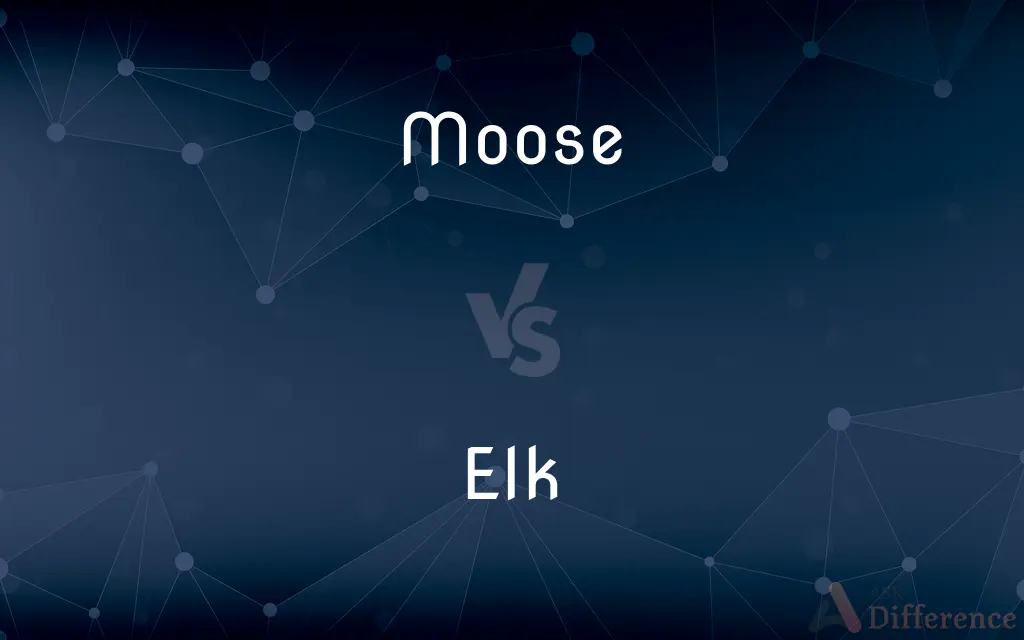Moose vs. Elk — What's the Difference?
Edited by Tayyaba Rehman — By Fiza Rafique — Updated on October 12, 2023
Moose are large deer native to North America and northern Eurasia, with broad, flat antlers. Elk, also known as wapiti, are large deer with pointed antlers, primarily found in North America and Eastern Asia.

Difference Between Moose and Elk
Table of Contents
ADVERTISEMENT
Key Differences
Moose and elk are both members of the deer family, Cervidae, but they represent different species. Moose, known by the scientific name Alces alces, are the largest members of this family. They are primarily characterized by their long, bulbous noses and broad, flat antlers. In contrast, elk, referred to scientifically as Cervus canadensis, are not as large as moose, and they possess more elongated, pointed antlers.
In terms of geographical range, moose are native to North America and northern Eurasia. In North America, they're predominantly found in the colder northern regions like Canada and the northern United States, particularly in forested areas with wetlands. Elk, on the other hand, primarily inhabit North America, but can also be found in Eastern Asia. In North America, they range from the eastern U.S. to the Pacific Northwest and from northern Canada down to Mexico.
Moose are generally solitary creatures, while elk tend to be more gregarious, often found in herds. The calls of the two animals are distinct too. A moose call, often a grunt or bellow, can be deep and resonating. In contrast, the bugling of elk, especially during mating season, is high-pitched and can carry for miles.
Dietarily, both moose and elk are herbivores. Moose primarily feed on aquatic vegetation, shrubs, and young trees. Elk, however, primarily graze on grasses, but they also consume shrubs and trees. Their feeding habits can vary based on the season and the availability of food.
Comparison Chart
Antlers
Broad, flat antlers
Pointed, branching antlers
ADVERTISEMENT
Size
Largest members of the deer family
Smaller than moose
Geographic Range
North America, northern Eurasia
North America, Eastern Asia
Behavior
Solitary
Gregarious, often in herds
Diet
Aquatic vegetation, shrubs, young trees
Grasses, shrubs, trees
Compare with Definitions
Moose
Largest deer species with broad, flat antlers.
The moose stood tall, dwarfing the other animals.
Elk
Large deer with pointed, branching antlers.
The elk's majestic antlers caught the sunlight.
Moose
Feeds on aquatic plants and vegetation.
The moose dipped its head to feed on the pond's plants.
Elk
Found in North America and Eastern Asia.
We watched a herd of elk graze in the Rockies.
Moose
Native to North America and northern Eurasia.
We spotted a moose while hiking in Canada.
Elk
Known for high-pitched bugling calls.
The elk's bugle echoed through the valley.
Moose
Primarily solitary in behavior.
The moose wandered alone in the wetland.
Elk
Often moves in herds and grazes on grasses.
The herd of elk moved together across the plain.
Moose
Recognized by its long, bulbous nose.
The moose's distinctive snout made it easy to identify.
Elk
Also known as wapiti.
The wapiti, or elk, is a symbol of the American West.
Moose
The moose (in North America) or elk (in Eurasia) (Alces alces), is a member of the New World deer subfamily and is the largest and heaviest extant species in the deer family. Most adult male moose have distinctive broad, palmate ("open-hand shaped") antlers; most other members of the deer family have antlers with a dendritic ("twig-like") configuration.
Elk
The elk (Cervus canadensis), also known as the wapiti, is one of the largest species within the deer family, Cervidae, and one of the largest terrestrial mammals in North America, as well as Central and East Asia. It is often confused with the larger Alces alces, which is called moose in North America, but called elk in British English, and related names in other European languages (German Elch, Swedish älg, French élan).
Moose
A large deer (Alces alces) of northern North American and Eurasian forests, having a broad pendulous muzzle, humped shoulders, and large, palmate antlers in the male.
Elk
A large reddish-brown or grayish deer (Cervus canadensis) of western North America, having long, branching antlers in the male. The elk is sometimes considered a subspecies of the closely related red deer. Also called wapiti.
Moose
The largest member of the deer family (Alces americanus, sometimes included in Alces alces), of which the male has very large, palmate antlers.
We saw a moose at the edge of the woods.
Elk
Chiefly British The moose.
Moose
Any of the extinct moose-like deer of the genera Cervalces and Libralces.
Elk
A light, pliant leather of horsehide or calfskin, tanned and finished to resemble elk hide.
Moose
An ugly person.
Elk
Any of various large species of deer such as the red deer, moose or wapiti (see usage notes).
Moose
An Asian girl taken as a lover.
Elk
Any of the subspecies of the moose (Alces alces, alternatively named Eurasian elk to avoid confusion with the wapiti), that occurs only in Europe and Asia.
Moose
A large cervine mammal (Alces alces syn. Alces machlis, syn Alces Americanus), native of the Northern United States and Canada. The adult male is about as large as a horse, and has very large, palmate antlers. It closely resembles the European elk, and by many Zoologists is considered the same species. See Elk.
Elk
Any moose (Alces alces), the largest member of the deer family.
Moose
A member of the Progressive Party; a Bull Moose.
Elk
(North America) common wapiti (Cervus canadensis), the second largest member of the deer family, once thought to be a subspecies of red deer.
Moose
A member of the fraternal organization named Loyal Order of Moose.
Elk
(British India) Sambar (Cervus unicolor).
Moose
Large northern deer with enormous flattened antlers in the male; called elk in Europe and moose in North America
Elk
A large deer, of several species. The European elk Alces alces (formerly Alces machlis or Cervus alces) is closely allied to the American moose. The American elk, or wapiti (Cervus Canadensis) the largest member of the deer family, has large, spreading antlers and is closely related to the European stag. See Moose, and Wapiti.
Elk
The European wild or whistling swan (Cygnus ferus).
Elk
A member of the fraternal organization named Benevolent and Protective Order of Elks, supporting various services to their communities.
Elk
Large northern deer with enormous flattened antlers in the male; called elk in Europe and moose in North America
Common Curiosities
Are elk antlers different from moose antlers?
Yes, elk have pointed, branching antlers while moose have broad, flat antlers.
Are moose and elk the same animal?
No, they are distinct species within the deer family.
Are elk also called wapiti?
Yes, another name for elk is wapiti.
Which is larger, moose or elk?
Moose are larger than elk.
Do moose and elk live in the same habitats?
While there's some overlap, moose prefer colder, wetter areas, and elk can be found in various terrains.
Do elk move in herds?
Yes, elk are gregarious and often found in herds.
What do moose typically eat?
Moose primarily eat aquatic vegetation, shrubs, and young trees.
Are moose more aggressive than elk?
Both can be aggressive, especially during mating season, but moose are often considered less predictable.
Is it common to see a solitary moose?
Yes, moose are generally solitary creatures.
Are moose antlers used for combat?
Yes, male moose use their antlers during mating season rivalries.
How can you distinguish an elk call?
Elk are known for their high-pitched bugling calls.
When do elk typically bugle?
Elk bugle primarily during the mating season.
Where can elk be found outside of North America?
Elk can also be found in Eastern Asia.
Do moose and elk have the same predators?
Both can be preyed upon by wolves and bears, but specific predators might vary by region.
Share Your Discovery

Previous Comparison
Substrate vs. Product
Next Comparison
Gypsies vs. RomaniansAuthor Spotlight
Written by
Fiza RafiqueFiza Rafique is a skilled content writer at AskDifference.com, where she meticulously refines and enhances written pieces. Drawing from her vast editorial expertise, Fiza ensures clarity, accuracy, and precision in every article. Passionate about language, she continually seeks to elevate the quality of content for readers worldwide.
Edited by
Tayyaba RehmanTayyaba Rehman is a distinguished writer, currently serving as a primary contributor to askdifference.com. As a researcher in semantics and etymology, Tayyaba's passion for the complexity of languages and their distinctions has found a perfect home on the platform. Tayyaba delves into the intricacies of language, distinguishing between commonly confused words and phrases, thereby providing clarity for readers worldwide.














































